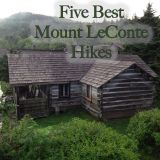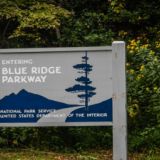Smoky Mountain Interstate Wildlife Crossing
Smoky Mountain Interstate Wildlife Crossing project plans to facilitate safe passage for area wildlife. Insuring a better way for wildlife to traverse the Pigeon River Gorge is the goal of the I-40 Pigeon River Gorge Wildlife Crossing Project designed to prevent close encounters of the fatal kind between animals and autos.
For many years, the ever encroachment of human settlements, infrastructural developments and expanding farmlands have interrupted crucial migration corridors vital to the preservation and growth of native species.
The project, a collaborative venture by the Great Smoky Mountains Association, the National Parks Conservation Association, Wildlandsnetwork and the Wilderness Society, aims to dramatically reduce the wildlife and human fatalities that occur each year as a result of wildlife-vehicle collisions.
The Safe Passage Project focuses on a 28-mile stretch of 1-40 which bisects the mountains of North Carolina and Tennessee and interrupts migration routes to the Great Smoky Mountains National Park from vast national forest lands to the northeast. A senior program manager for Wildlands Network stated that reconnecting the public land bisected by 1-40 will allow wildlife to safely move north.
These groups of concerned citizens are researching wildlife traffic patterns and mortality in the gorge and this information will provide prevention measures designed to reduce the incidents of collisions between man and nature.
Creative solutions include fences that will funnel animals to overpasses and underpasses and can work in tandem with plans already in the works by the department of transportation to replace bridge sites near White Oak Road, Harmon Den and the Pigeon River south of Fines Creek. These new constructions offer opportunities to enhance safety routes for wildlife in this Southern Appalachian region which has one of the highest levels of biodiversity in North America.
Not only are the roads deadly but, according to Wildlandsnetwork, a leader in the field of road ecology, they also prove barriers to wildlife movement and can cause genetic isolation within populations thus contributing to biodiversity decline.
Historically wildlife traffic had few barriers while migrating to new territories. When the 1-40 highways were constructed during the 20th century, the impact on wildlife was not considered and a spokesperson for the Wilderness Society indicated this lack of forethought dramatically curtailed wildlife movement.
There are three major factors to consider in stabilizing animal populations in a given region.
Colonization – Habitat corridors enable animals to move and occupy new areas when food sources or other natural resources are unavailable in their core habitat.
Migration – Many species migrate for survival during various seasons.
Interbreeding – such corridors allow animals to find new mates in neighboring regions and ensure an increase for genetic diversity.
According to Wildfire Community Planning, safe passage corridors are currently in use in many areas in the United States and indeed the world including an elephant underpass in Mt. Kenya National Forest in Kenya and a 62m bridge, built in 1986 and the only crossing of its kind in Southeast Asia, that spans the Bukit Timah Expressway and Central Catchment Nature Reserve
Other safe corridors include:
The Yellowstone to Yukon Conservation Iniative Canada-United States is a charitable organization that protects connecting habitats for some 2,000 miles along the Rocky Mountains of North America. From Yellowstone National Park to the Yukon such corridors provide safe travels for pronghorns, grizzly bears, black bears, elk, cougars and other animals.
U.S. Highway 83 North in Montana has the most extensive safe crossings in the country. A total of 41 wildlife and fish crossing structures were built along the 56-mile stretch of road.
Banff National Park, Canada is home to a wide range of large species such as grizzly bears, elks and wolverine. The TransCanada Highway bisects the area and created a critical barrier for wildlife movement. Several man-made overpasses and underpasses were built to allow safe migration routes for the animals.
Natuurbrug Zanderij Cralio, Netherlands has more than 600 man-made overpasses and underpasses along busy highways including the longest man-made corridor in the country which spans a railway, business park, river, and highway and sports complex.
Christmas Island National Park, Australia –not all safe passages involve large species. Millions of crabs, which live deep in the island’s forests, annually migrate across roads, golf courses and beaches in order to breed and lay eggs. More than 12 miles of barriers were constructed to move the crabs into 31 underpasses and onto a crab bridge that crosses over one of the areas busiest roads.
Perhaps the most unusual safe-passage is a bee corridor in Oslo Norway, a one of a kind, which offers a network of pollen-producing plants. These bee-friendly sites are located in a variety of spaces including roof-top gardens and balconies. The goal is to provide pollen-rich habitats every 800 feet.












